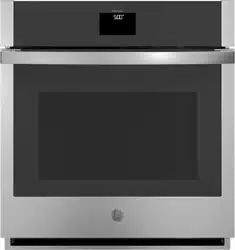Documents: Go to download!
- Owner's manual - (English, Spanish)
- USING THE OVEN
- CARE AND CLEANING
- TROUBLESHOOTING TIPS
Table of contents
User Manual Smart Built-In Convection Single Wall Oven
USING THE OVEN
Single Wall Oven Controls
Control button shapes are representative; your oven may have alternate button shapes. Control buttons are designed to become visible when the oven door is opened or if the controls are pressed in the area of a button.
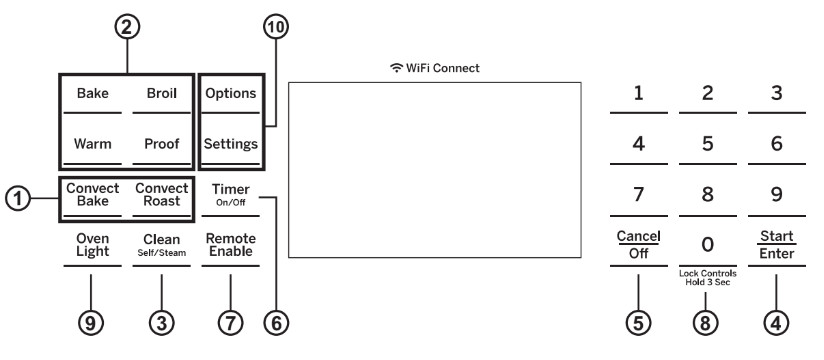
1. Convection Cooking Modes: Convection cooking modes use increased air circulation to improve performance. The type of benefit depends on the mode. Your oven has the following Convection Roast. See the Cooking Modes section for more information.
2. Traditional Cooking Modes: Your oven has the following traditional cooking modes: Bake, Broil, Proof and Warm. See the Cooking Modes section for more information.
3. Clean: Your oven has two cleaning modes: Self Clean and Steam Clean. See the Cleaning the
Oven section for important information about using these modes.
4. Start/Enter: Must be pressed to start any cooking, cleaning, or timed function. NOTE: If your display and keys dim, opening the oven door or pressing any key will wake and illuminate the control.
5. Cancel/Off: Cancels ALL oven operations except the clock and timer.
6. Timer: Works as a countdown timer. Press the Timer pad and use the number pads to program the time in hours and minutes. Press the Start/Enter pad. The oven will continue to operate when the timer countdown is complete. To turn the timer off, press the Timer pad.
7. Remote Enable: Allows you to control your oven remotely. The oven must be connected to WiFi before Remote Enable can be activated. For instructions on how to connect your oven, see the WiFi Connect/Remote Enable section under Settings in this manual.
8. Lock Controls: Locks out the control so that pressing the pads does not activate the controls. Press and hold the 0 pad, for three seconds to lock or unlock the control. Cancel/Off is always active, even when the control is locked.
9. Oven Light: Turns the oven light on or off.
10. Options and Settings: The Options and Settings pads open up more detailed menus in the
display that allow access to additional functions and cooking modes. For each, you select the function in the display using the associated number pad. You can exit at any time by pressing the Options or Settings pad again. See the Settings, Options, and Cooking Modes Sections for more details.
Double Wall Oven Controls
Control button shapes are representative; your oven may have alternate button shapes. Control buttons are designed to become visible when the oven door is opened or if the controls are pressed in the area of a button.
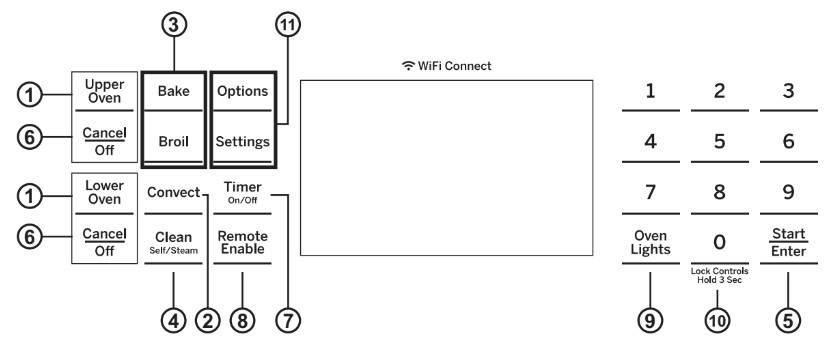
1. Upper Oven and Lower Oven: Designates which oven the controls will operate. bSelect an oven before following the steps for starting a cooking or cleaning mode.
2. Convection Cooking Modes (upper oven only): Convection cooking modes use increased air circulation to improve performance. See the Cooking Modes section for more information.
3. Traditional Cooking Modes: Your oven has the following traditional cooking modes: Bakr, Broil and Warm. See the Cooking Modes section for more information.
4. Clean: Your oven has two cleaning modes: Self Clean and Steam Clean. See the Cleaning the
Oven section for important information about using these modes.
5. Start/Enter: Must be pressed to start any cooking, cleaning, or timed function. NOTE:If your display and keys dim, opening the oven door or pressing any key will wake and illuminate the control.
6. Cancel/Off: Cancels ALL oven operations except the clock and timer.
7. Timer: Works as a countdown timer. Press the Timer pad and use the number pads to program the time in hours and minutes. Press the Start/Enter pad. The oven will continue to operate when the
timer countdown is complete. To turn the timer off, press the Timer pad.
8. Remote Enable: Allows you to control your oven remotely. The oven must be connected to
WiFi before Remote Enable can be activated. For instructions on how to connect your oven, see
WiFi Connect/Remote Enable section under Settings in this manual.
9. Oven Light(s): Turns the oven light on or off.
10. Lock Controls: Locks out the control so that pressing the pads does not activate the controls.
Press and hold the 0 pad, for three seconds to lock or unlock the control. Cancel/Off is always active, even when the control is locked.
11. Options and Settings: The Options and Settings pads open up more detailed menus in the display that allow access to additional functions and cooking modes. For each, you select the function in the display using the associated number pad. You can exit at any time by pressing the Options or Settings pad again. See the Settings, Options, and Cooking Modes Sections for more details.
Options
The options pad opens up a menu cooking modes when oven is off. It opens a menu with additional features if a cooking mode is already in process. You can exit the menu at any time by pressing the Optios pad again.
You must first select a mode (bake, convection bake, convection roast) and then select Options to get to the following functions.
Cook Time
Counts down cooking time and turns off the oven when the cooking time is complete. Initiate either a bake or warm mode, but don't press Start. Press the Options pad, follow the screen prompts and use the number pads to program a cooking time in hours and minutes, then press Start.
Delay Time
Delays when the oven will turn on. Use this to set a time when you want the oven to start. Select a desired cooking mode. Use the number pads to program a baking temperature. Press Options pad and select Delay Time. Use the number pads to program the time of day for the oven to turn on, and then press Start/Enter. With cooking modes, a cook time may also be programmed if desired. Follow the directions under Cook Time for setting this feature. Delay Time is not available with all modes.
NOTE: When using the Delay Time feature, foods that spoil easily – such as milk, eggs, fish, stuffing, poultry, and port – should not be allowed to sit for more than 1 hour before or after cooking. Room temperature promotes the growth or harmful bacteria. Be sure that the oven light is off because heat from the bulb will speed harmful bacteria growth.
Oven Probe (upper only on double oven modes)
Note: Only accessible through traditional and convection cooking modes.
Monitors internal food temperature and turn the oven off when the food reaches the programmed temperature. Insert the probe, press the desired cooking mode, and program the probe temperature. The probe can only be used with Bake, Convection Bake, and Convection Roast.
Settings
The Options and Settings pads open up more detailed menus in the display that allow access to additional functions. For each you select the function in the display using the associated number pad. You can exit at any time by pressing the Options or Settings pad again.
WiFi Connect and Remote Enable
Your oven is designed to provide you with two-way communication between your appliance and smart between your appliance and smart device. By using the Wifi Connect feature, you will be able to control essential oven operations such as temperature settings, timers and cooking modes using
your smartphone or tablet.*
Select Settings then Wifi then follow the instructions on your phone app. It is necesssary to turn on Wifi before using Remote Enable on your oven.
Connecting your WiFi Connect Enabled Oven
What you will need
Your GE Appliances oven uses your existing home WiFi network to communicate between the appliance and your smart device. In order to setup your GE Appliances oven, you will need to gather some information:
1. You will need to know the Appliance Network Name and Password to connect to the appliance. Select Settings then Wifi to display the SSID and Password on your control.
2. Have your smart phone or tablet ready with the ability to access the internet and download apps.
3. You will need to know the password of your home WiFi router. Have this password ready while you are setting up your GE Appliances oven.
Connect your GE Appliances oven
1. On your smart phone or tablet visit GEAppliances.com/connect to learn more about
connected appliance features and to download the appropriate app.
2. Follow the app onscreen instructions to connect your GE Appliances oven.
3. Once the process is complete, the connection light located on your GE Appliances oven display will stay on solid and the app will confirm you are connected.
4. If the connection light does not tuen on or is blinking, follow the instruction on the app to reconnect. If issues continue, please call the Connected Call Center 1.866.626.2000 and ask for assistance regarding oven wireless connectivity.
To connect additional smart devices, disconnect from WiFi and the first device, then reconnect to WiFi and repeat steps 1 and 2. The unit can only be connected to one device at a time.
Note that any changes or modifications to the remote enable device installed on this oven that are not expressly approved by the manufacturer could void the user’s authority to operate the equipment.
REMOTE STARTING YOUR OVEN 
To be able to start the oven remotely once connected to WiFi, press the Remote Enable pad and the  icon will turn on in the display. The oven can now be remotely started with a connected device. The icon
icon will turn on in the display. The oven can now be remotely started with a connected device. The icon  must be lit to start the oven remotely. The icon
must be lit to start the oven remotely. The icon  is not required to change the oven temperature while it is running, set a timer or to turn the oven off from the phone app while the icon
is not required to change the oven temperature while it is running, set a timer or to turn the oven off from the phone app while the icon  shows it is Wifi Connected.
shows it is Wifi Connected.
To disconnect your phone from Remote Enable, press the Remote Enable pad and the icon  will turn off.
will turn off.
NOTE: Foods that spoil easily - such as milk, eggs, fish, stuffings, poultry and prok - should not be allowed to sit for more than 1 hour before or after cooking. Room tamperature promotes the growth of harmful bacteria. Be sure that the oven light is off because heat from the bulb will speed harmful bacteria growth.
Clock
This setting sets the oven clock time. Press the Settings pad and select Clock. Select Set Clock and follow the instructions to set the clock. This feature also specifies how the time of day will be displayed. You can select a standard 12-hour clock (12H), 24-hour military time display (24H), or no clock displayed (Off). Press the Settings pad, select Set Clock and select either 12/24 hr or On/Off.
Auto Conv (Auto Conversion)
When using Convection Bake cooking, Auto Recipe Conversion will automatically convery the Conversion will automatically convert the regular baking temperatures entered to convection bake cooking does not convert convection bake cooking times, it only converts temperatures. This feature may be turned on or off. Select Settings and Auto Conversion then follow the prompts to turn this feature on or off.
Auto Off
This feature shuts the oven down after 12 hours of continous operation. It may be anabled or disabled. Select Settings and Auto Off to turn this feature on or off.
Sound
You can adjust the volume and type of alert your appliance uses. Select Settings and Sound. Follow
prompts for making volume adjustments or for changing between continuous and single alert tones. A continuous setting will continue to sound a tone until a button on the control is pressed. The oven tone volume can be adjusted. The control will sound the oven tone at the new volume level each time the sound level is changed.
F/C (Fahrenheit or Celsius)
The oven control is set to use Fahrenheit temperatures (F), but you can change it to use Celsius temperatures (C). Select Settings and F/C to alter between temperature scales displayed.
Adjust the Oven temperature
This feature allows the oven baking and convection baking temperature to be adjusted up to 35oF hotter or down to 35°F cooler. Use this feature if you belive your oven temperature is too hot or tow cold and wish to change it. This adjustment affects Bake and Convection Bake modes. Nos other cooking modes are affected. Select Settings and Oven Adjust to add More Heat or Less Heat and then press Save (for double ovens use the Upper Oven or Lower Oven menu selection corresponding to the ovwn to be adjusted). Do not use thermometers, such as those found in grocery stores, to check the temperature setting of your oven. These thermometers may vary 20-40 degrees.
Oven Info
Select Settings and Oven Info to display the Model Number and Software Version.
Sabbath
Sabbath mode disables the oven lights (the oven light will not turn on when the door is opened), all sounds (the control will not beep when a button is pressed), Convection, Broil, Warm, Proof, Cook Time, Timer, Clock, and Delay Time functions. Sabbath mode can only be used with Bake. This feature conforms to the Star-K Jewish Sabbath requirements.
To use Sabbath mode, press Settings, select Sabbath, and select Turn Sabbath On. A ] will appear in the display and the clock will not display.
Note that if you have a double wall oven, when you place the control into Sabbath mode, both ovens are now in Sabbath mode and available for cooking.
Once in Sabbath mode, at any time you can press Bake, use the number pads to enter a temperature between 170F and 550F, and press Start. No sound will be given when the keys are pressed. At a random time between 30 seconds and 1 minute, ][, will appear in the display indicating the oven is running.
Note that both ovens of a double wall oven can be used in Sabbath mode. Each oven can be programmed to a different temperature and each oven must be programmed separately.
If you need to adjust the temperature, press Bake, use the number pads to enter a new temperature between 170F and 550F, and press Start.
To turn the oven off, press Cancel/Off at any time. The oven will immediately turn off and ][ will change to ] indicating that the oven has turned off.
Note that each oven of a double wall oven must be turned off separately.
To exit Sabbath mode, make sure that the oven is turned off. Press and hold the Settings pad to turn Sabbath mode off.
NOTE: If power outage occurs during Sabbath mode the unit will remain in Sabbath mode but off when power is restored.
If you wish to use the Cook Time feature to bake in the oven and then have the oven automatically turn off, you will need to press the Cook Time pad, enter a cooking time duration, and press Start. Then enter special features to start Sabbath mode as detailed above
Oven Racks
Your oven has six rack positions. Recommended rack positions for various types of foods are provided in the Cooking Guide. Adjusting rack position is one way to impact cooking results. For example, if you would prefer darker tops on cakes, muffins, or cookies, try moving food one rack position higher. If you find foods are too brown on top try moving them down next time.
When baking with multiple pans and on multiple racks, ensure there is sufficient space between pans to allow air to flow.
Your Oven may have extension racks and/or traditional flat racks.
To avoid possible burns, place the racks in the desired position before you turn the oven on.
Traditional Flat Racks
When placing and removing cookware, pull the rack out to the bump (stop position) on the rack support.
To remove a rack, pull it toward you, tilt the front end up and pull it out.
To replace, place the curved end of the rack (stop-locks) onto the oven supports, tilt up the front of the rack and push the rack in.
Racks may become difficult to slide, especially after a self-clean. Put some vegetable oil on a soft cloth or paper towel and rub onto the left and right edges of the racks.
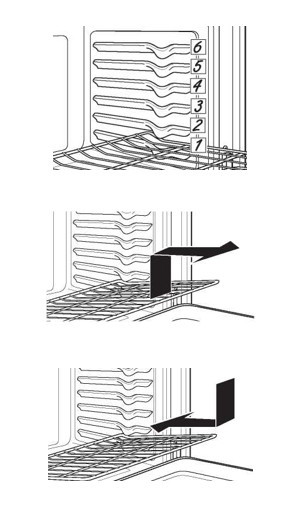
Extension Racks
Always pull the rack out by its upper front rail to its fully open position, when placing or removing cookware. Extension racks cannot be used in the top rack position.
If extension racks are difficult to extend, lubricate the racks with the graphite lubricant provided with your oven. Remove the rack from the oven, remove debris in the side tracks with a paper towel, shake the graphite lubricant and place 4 small drops on the two bottom tracks of the left and right sides. Open and close the rack several times to distribute the lubricant.
To order additional graphite lubricant, read the Accessories section of the manual.
To Remove An Extension Rack:
1. Make sure the rack is pushed all the way into the oven so that side paddles on the rack disengage from the oven support.
2. Slide the rack toward you to the bump (stop position) on the rack support.
3. Firmly grasp both sides of the rack frame and the sliding rack, tilt the front end up and pull it out.
To Replace An Extension Rack:
1. Firmly grasp both sides of the rack frame and the sliding rack.
2. Place the curved end of the rack (stop-locks) onto the oven supports, tilt up the front of the rack and push it in as far as it will go.
If extension racks are difficult to replace or remove, wipe the oven rack supports with cooking oil. Do not wipe oil on the rack slides.
To Lubricate the Paddle:
Shake lubricant and apply to the moving parts of the paddle mechanisms as shown.
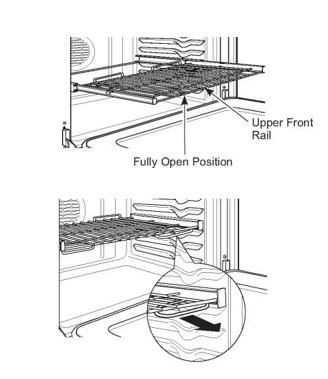
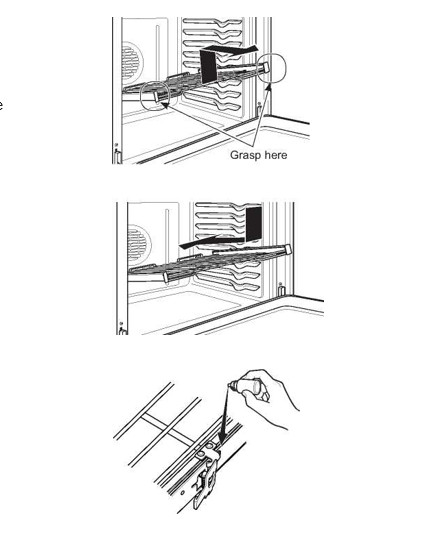
Aluminum Foil and Oven Liners
CAUTION: Do not use ant type of foil or oven bottom. These items can trap heat or melt, resulting in damage to the product and risk of shock, smoke or fire. Damage from improper use of these items is not covered by the product warranty.
Foil may be used to catch spills by placing a sheet on a lower rack, several inches below the food. Do not use more foil than necessary and never entirely cover an oven rack with aluminum foil. Keep foil at least 1-1/2” from oven walls to prevent poor heat circulation.
Cookware
Cookware Guidelines
The material, finish, and size of cookware affect baking performance.
Dark, coated and dull pans absorb heat more readily than light, shiny pans. Pans that absorb heat more readily can result in a browner, crisper, and thicker crust. If using dark and coated cookware check food earlier than minimum cook time. If undesirable results are obtained with this type of cookware consider reducing oven temperature by 25° F next time.
Shiny pans can produce more evenly cooked baked goods such as cakes and cookies.
Glass and ceramic pans heat slowly but retain heat well. These types of pans work well for dishes such as pies and custards.
Air insulated pans heat slowly and can reduce bottom browning.
Keep cookware clean to promote even heating.
Cooking Modes
Your new oven has a variety of cooking modes to help you get the best results. These modes are described below. Refer to the Cooking Guide section for recommendations for specific foods. Remember, your new oven may perform differently than the oven it is replacing.
Baking and Roasting Modes
Select a mode for baking and roasting based on the type and quantity of food you are preparing. When preparing baked goods such as cakes, cookies, and pastries always preheat the oven first. Follow recipe recommendations for food placement. If no guidelines are provided, center food in the oven.
Traditional Bake
The traditional bake mode is intended for single rack cooking. This mode uses heat primarily from the lower element but also from the upper element to cook food. To use this mode press the Bake pad, enter a temperature, and then press Start. Preheating is generally recommended when using this mode.
Convection Bake (upper only on double oven models)
The Convection Bake mode is intended for baking on multiple racks at the same time. This mode uses heat primarily from the rear element but also heat from the upper and lower elements, along with air movement from the convection fan to enhance cooking evenness. Your oven is equipped with Auto Recipe Conversion, so it is not necessary to convert the temperature when using this mode. Baking time might be slightly longer for multiple racks than what would be expected for a single rack. To use this mode press the Convection pad, then select Convection Bake, enter a temperature, and then press Start. Always preheat when using this mode.
Convection Roast (upper only on double oven models)
The Convection Roast mode is intended for roasting whole cuts of meat on a single rack. This mode uses heat from the lower, upper, and rear elements along with air movement from the convection fan to improve browning and reduce cooking time. It is not necessary to convert temperature. Check food earlier than the recipe suggested time when using this mode or use a meat probe. To use this mode press the Convection pad, then select Convection Roast, enter a temperature, and then press Start. It is not necessary to preheat when using this mode.
Broiling Modes
Always broil with the door closed. The broil element in this oven is very powerful. Monitor food closely while broiling. Use caution when broiling on upper rack positions as placing food closer to the broil element increases smoking, spattering, and the possibility of fats igniting. For best performance center food below the broil heating element. Broiling on rack position 6, in single and lower cavities, is not recommended.
Try broiling foods that you would normally grill. Adjust rack positions to adjust the intensity of the heat to the food. Place foods closer to the broil element when a seared surface and rare interior is desired. Thicker foods and foods that need to be cooked through should be broiled on a rack position farther from the broiler or by using Broil Lo.
Broil Hi
The Broil Hi mode uses intense heat from the upper element to sear foods. Use Broil Hi for thinner cuts of meat and/or foods you prefer less done on the interior.
To use this mode press the Broil pad, then select Hi Broil, and press Start. It is not necessary to preheat when using this mode.
Broil Lo
The Broil Lo mode uses less intense heat from the upper element to cook food thoroughly while also producing surface browning. Use Broil Lo for thicker cuts of meat and/or foods that you would like cooked all the way through. To use this mode press the Broil pad, then select Lo Broil, and press Start. It is not necessary to preheat when using this mode.
Proof
Proof mode is designed for rising (fermenting and proofing) bread doughs. In some models, Proof is found by selecting Options. Press Proof and then press Start. Cover dough well to prevent drying out. Bread will rise more rapidly than at room temperature. Note that for double wall ovens, proof can not be run when running a clean mode in the lower oven.
Warm
Warm mode is designed to keep hot foods hot for up to 3 hours. In some models, Warm is found by selecting Options. Press Warm and then press Start. Cover foods that need to remain moist and do not cover foods that should be crisp. Preheating is not required. Do not use warm to heat cold food other than crisping crackers, chips or dry cereal. It is also recommended that food not be kept warm for more than 2 hours.
Probe
WARNING
Consuming undercooked food can result in foodborne illness. Use probe according to the following instructions to ensure all portions of the food reach minimum safe cooking temperatures. Recommendations for minimum safe food temperatures can be found at foodsafety.gov or IsItDoneYet.gov.
Internal food temperature is frequently used as an indicator of doneness, especially for roasts and poultry. The Probe mode monitors the internal food temperature and turns the oven off when the internal food temperature reaches the programmed temperature.
Always check the temperature at multiple locations in the food with a food thermometer after cooking to ensure that all portions of the food have reached the minimum safe internal temperature for that food.
Proper Probe Placement
After preparing the meat and placing it on the cooking pan follow these instructions for proper probe placement.
■ Insert the probe into the food, so that the tip of the probe will rest in the center of the thickest part of the food. For best performance the probe should be fully inserted into the food. If the probe is not located properly, it may not accurately measure the temperature of the coolest portion of the food. Some foods, particularly small items, are not well suited for cooking with the probe due to their shape or size.
■ The probe should not touch bone, fat or gristle.
■ For whole poultry insert the probe into the thickest part of the breast.
■ For boneless roasts, insert the probe into the center of the roast.
■ For bone-in ham or lamb, insert the probe into the center of the lowest large muscle or joint.
■ For casseroles or dishes such as meatloaf, insert the probe into the center of the dish.
■ For fish, insert the probe from just above the gill into the meatiest area, parallel to the backbone.
Probe Usage
The temperature probe can only be used with Bake, Convection Bake, and Convection Roast.
To use the probe with preheating:
1. Select the desired cook mode (Bake, Convection Bake, or Convection Roast) pad and enter the desired cooking temperature with the number pads.
2. Insert the probe into the food (see Proper Probe Placement).
3. Once the oven is preheated, place the food in the oven and connect the probe to the probe outlet, making sure it is fully inserted. Use caution, the oven walls and probe outlet are hot.
4. When the probe is connected, the display will prompt you to enter the desired food temperature. The maximum internal food temperature that you can set is 200° F.
To use the probe without preheating:
1. Insert the probe into the food (see Proper Probe Placement).
2. Place the food in the oven and connect the probe into the probe outlet in the oven.
3. Press the Cook Mode pad (Traditional Bake, Convection Bake, or Convection Roast) and
enter the desired cooking temperature with the number pads. Press Options and select Probe then follow the display prompts to enter the desired food temperature.
Probe Care Guidelines
■ Use of probes other than the one provided with this product may result in damage to the probe outlet.
■ Use the handles of the probe and plug when inserting and removing them from the meat and outlet
■ To avoid damaging your probe, do not use tongs to pull on the cable when removing it.
■ To avoid breaking the probe, make sure food is completely defrosted before inserting the probe.
■ To prevent possible burns, do not unplug the probe from the outlet until the oven has cooled.
■ Never leave the probe inside the oven during a self or steam clean cycle.
■ Do not store the probe in the oven.
Cooking Guide - Lower Oven

*When baking four cake layers at a time, use racks 2 and 4. Place the pans as shown so that one pan is not directly above another.
Cook food thoroughly to help protect against food borne illness. Minimum safe food temperature recommendations for food safety can be found at IsItDoneYet.gov. Make sure to use a food thermometer to take food temperatures.

Cooking Guide - Upper/Single Oven
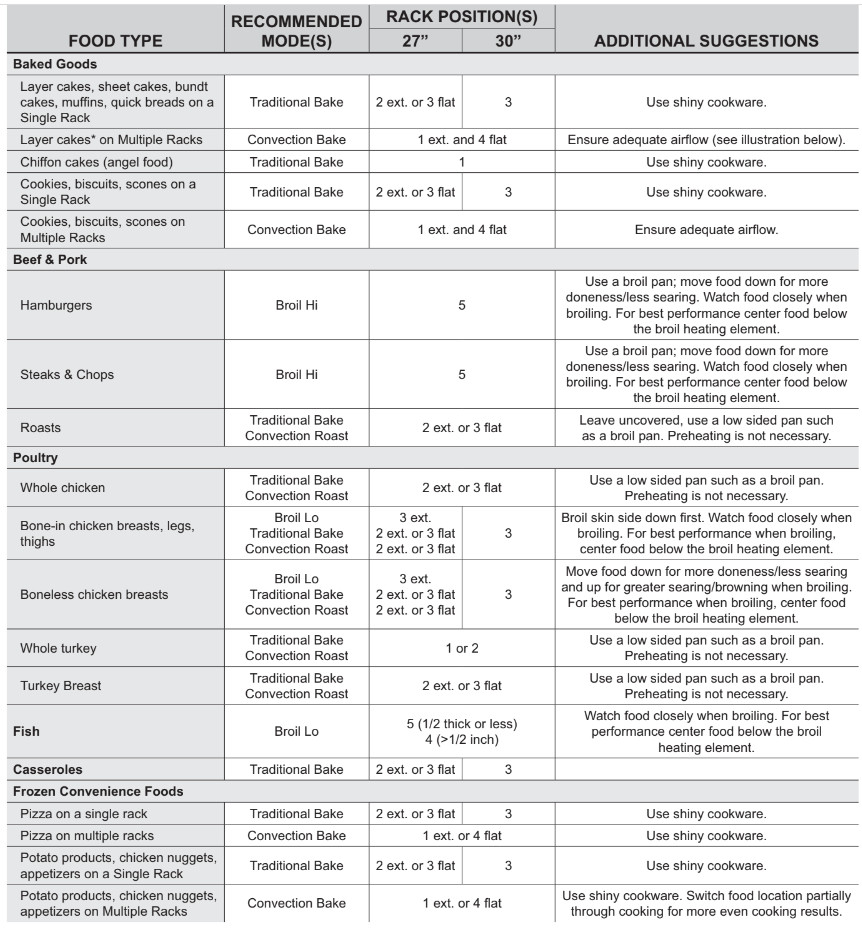
*When baking four cake layers at a time, use racks 1 and 4. Place the pans as shown so that one pan is not directly above another.
Cook food thoroughly to help protect against food borne illness. Minimum safe food temperature recommendations for food safety can be found at IsItDoneYet.gov. Make sure to use a food thermometer to take food temperatures.
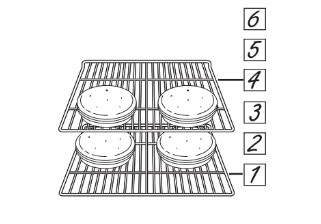
CARE AND CLEANING
Oven
Be sure electrical power is off and all surfaces are cool before cleaning any part of the oven
Control Panel
It's a good idea to wipe the control panel after each use. Clean with mild soap and water or vinegar and water, rinse with clean water and polish dry with a soft cloth.
Do not use abrasive cleaners, strong liquid cleaners, plastic scouring pads or oven cleaners on the control panel-they will damage the finish.
Oven Exterior
Do not use oven cleaners, abrasive cleansers, strong liquid cleansers, steel wool, plastic scouring pads, or cleaning powders on the interior or exterior of the oven. Clean with a mild soap and water or vinegar and water solution. Rinse with clean water and dry with a soft cloth. When cleaning surfaces, make sure that they are at room temperature and not in direct sunlight.
If stain on the door vent trim is persistent, use a mild abrasive cleaner and a sponge-scrubber for best results. Spillage of marinades, fruit juices, tomato sauces and basting liquids containing acids may cause discoloration and should be wiped up immediately. Let hot surfaces cool, then clean and rinse.
Painted Surfaces and Black Stainless Steel (on some models)
Painted surfaces may include the door and trim around Do not use comericial oven cleaners, cleaning powders. the control panel. Clean these with soap and water or a vinegar and water solution. steel wool or harsh abrasives on any painted surface, including Black Stainless Steel.
Stainless Steel - Excluding Black Stainless Steel (on some models)
Do not use a steel wool pad; it will scratch the surface. Cleanser™ will remove surface rust, tarnish and small.
To clean the stainless steel surface, use warm sudsy water or a stainless steel cleaner or polish. Always wipe the surface in the direction of the grain. Follow the cleaner instructions for cleaning the stainless steel surface. Cleaners with oxalic acid such as Bar Keepers Friend Soft blemishes. Use only a liquid cleanser free of grit and rub in the direction of the brush lines with a damp, soft sponge. To inquire about purchasing cleaning products including stainless steel appliance cleaner or polish read the Accessories sections of this manual.
Oven Interior
The interior of your new oven can be cleaned manually or by using the Steam Clean or Self Clean modes. Spillage of marinades, fruit juices, tomato sauces and basting liquids containing acids may cause discoloration and should be wiped up immediately. Let hot surfaces cool, then clean and rinse.
Manual Cleaning
Do not use oven cleaners, abrasive cleaners, strong liquid cleansers, steel wool, scouring pads, or cleaning powders on the interior of the oven. Clean with a mild soap and water or vinegar and water solution. Rinse with clean water and dry with a soft cloth. When cleaning surfaces, make sure that they are at room temperature. Steam Clean Mode
Steam clean is intended to clean small spills using water and a lower cleaning temperature than Self-Clean.
To use the Steam Clean feature, wipe grease and soils from the oven. Pour one cup of water into the bottom of the oven. Close the door. Press the Clean pad twice and then press Start. The oven door will lock. You can not open the door during the 30 minute steam clean as this will decrease the steam clean performance. At the end of the steam clean cycle the door will unlock. Wipe out any excess water and any remaining soil.
NOTE: Water in the bottom of the oven may be hot right after finishing the cycle.
Self Clean Mode
Read Self-Cleaning Oven Safety Instructions at the beginning of this manual before using Self Clean Mode. Self clean uses very high temperatures to clean the oven interior. The oven door will lock when using this feature. Before operating the self-clean cycle, wipe up grease and soils from the oven. Remove all items from the oven other than enameled (dark color) racks. Shiny or silver racks, the meat probe, and any cookware or other items should all be removed from the oven before initiating a self-clean cycle. Close the door. Press the Clean pad once and a default self-clean time is displayed. The clean time can be changed to any time between 3:00 and 5:00 hours by using the number pads to enter a different time and pressing Start. For heavily soiled ovens, the maximum 5 hour clean time is recommended. If you wish to use the default time, press the Start pad immediately after pressing the Clean pad. The oven will turn off automatically when the self-clean cycle is complete. The door will stay locked until the oven has cooled down. After the oven has cooled down wipe any ash out of the oven.
IMPORTANT: The health of some birds is extremely sensitive to the fumes given off during the self-cleaning cycle of any range. Move birds to another well-ventilated room.
Oven Racks
Racks that are enameled, not shiny, can be left in the. Racks may be more difficult to slide, especially after a cavity during self clean, or can be washed with warm, self-clean. Put some vegetable oil on a soft cloth or paper soapy water.towel and rub onto the left and right edges.
Probe
The temperature probe may be cleaned with soap and water or a soap-filled scouring pad. Cool the temperature probe before cleaning. Scour stubborn spots with a soap-filled scouring pad, rinse and dry.
To order additional temperature probes read the Assistance and Accessories sections at the beginning of this manual.
- Do not immerse the temperature probe in water.
- Do not store the temperature probe in the oven.
- Do not leave the temperature probe inside the oven during a self or steam clean cycle.
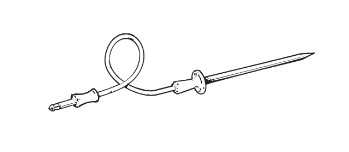
Oven Light
WARNING: SHOCK OR BURN HAZARD: Before replacing oven light bulb, disconnect the electrical power to the oven at the main fuse or circuit breaker panel. Failure to do so may result in electric shock or burn.
CAUTION: BURN HAZARD: The glass cover and bulb should be removed when cool. Touching hot glass with bare hands or a damp cloth can cause burns.
1. Disconnect power at the main fuse or circuit breaker panel.
2. Remove oven racks.
3. Slide a flat blade screwdriver or butter knife between the metal housing and the glass light cover.
NOTE: on some models there is a metal clip visibly holding the glass. The tool needs inserted between the metal housing and the clip holding the glass.
4. Support the glass light cover with two fingers to prevent the cover from falling to the bottom of the oven.
5. Gently twist the screwdriver blade or butter knife to loosen the glass light cover. Be careful not to chip the oven coating.
6. Remove the glass light cover.
7. Remove the bulb by firmly grasping and sliding the bulb straight out until the two prongs have cleared the ceramic holder.
8. Do not touch the glass of the new replacement bulb ưith your fingers. It will cause the bulb to fail when it lights. Grasp the replacement bulb with a clean towel or facial tissue with the prongs facing down. Align the two prongs in the ceramic holder, pressing gently until the bulb is securely in the ceramic socket.
9. Slide the protective lens into the holder and push until the clips snap into the housing.
10. Reconnect power.
Oven Door
Oven Door Removal
NOTE: Door removal is not a requirement for installation of the product but is an added convenience.
To remove the door:
1. Open the oven door as far as it will go.
2. Remove hinge bracket (if present) from front frame and set aside. The hinge bracket must be replaced for proper door functionality when door is reinstalled.
3. Push both hinge locks down toward the door frame to the unlocked position. This may require a flat-blade screwdriver. DO NOT LIFT THE DOOR BY THE HANDLE!
4. Place hands on both sides of the door and close the oven door to the removal position (approximately 1”-2” [2.5 cm-5.1 cm] from the closed position).
5. Lift the door up and out until the hinge arms clear the slots. NOTE: The oven door is very heavy. Be sure you have a firm grip before lifting the oven door off the hinges. Use caution once the door is removed. Do not lay the door on its handle. This could cause dents or scratches.

Replacing the Oven Door
NOTE: The oven door is heavy. You may need help lifting the door high enough to slide it into the hinge slots.
Do not lift the door by the handle.
1. Lift the oven door by grasping each side.
2. With the door at the same angle as the removal position (approximately 1”-2” [2.5 cm-5.1 cm] from the closed position), seat the notch of the hinge arm into the bottom edge of the hinge slot. The notch of the door functionality.
6. Close the oven door. hinge arm must be fully seated into the bottom of the slot.
3. Fully open the door. If the door will not fully open, the indentation is not seated correctly in the bottom edge of the slot.
4. Push the hinge locks up against the front frame of the oven cavity, to the locked position.
5. Replace hinge bracket (if present). The hinge bracket must be replaced for proper
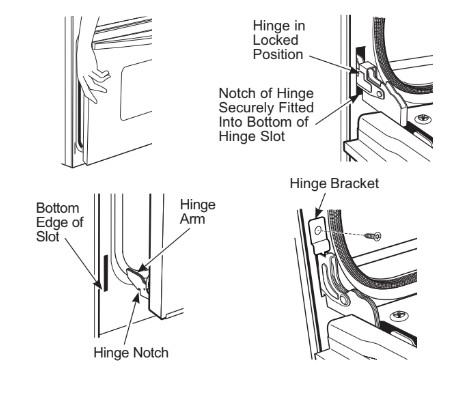
TROUBLESHOOTING TIPS
1. My new oven doesn't cook like my old one. Is something wrong with the temperature settings?
- Your new oven has a different cooking system from your old oven and therefore may cook differently than your old oven.
- For the first few uses, follow your recipe times and temperatures carefully. If you still think your new oven is too hot or too cold, you can adjust the temperature yourself to meet your specific cooking preference. NOTE: This adjustment affects Bake and Convection Bake Multi; it will not affect Convection Roast, Broil or Clean.
2. Food does not bake properly
- Oven controls improperly set.
- See the Cooking Modes section.
- Rack position is incorrect or rack is not level.
- See the Cooking Modes section and Cooking Guide.
- Incorrect cookware or cookware of improper size being used.
- See the Cookware section.
- Oven temperature needs adjustment.
- See the Settings section.
- Ingredient substitution
- Substituting ingredients can change the recipe outcome.
3. Food does not broil properly
- Oven controls improperly set.
- Make sure you select the appropriate broil mode.
- Improper rack position being used.
- See Cooking Guide for rack location suggestions.
- Food being cooked in a hot pan.
- Make sure cookware is cool.
- Cookware not suited for broiling.
- Use a pan specifically designed for broiling.
- Aluminum foil used on the broiling pan and grid has not been fitted properly and slit as recommended.
- If using alumium foil conform to pan slits.
- In some areas the power (voltage) may be low.
- Preheat the broil element for 10 minutes.
4. Oven temperature too hot or too cold
- Oven temperature needs adjustment.
- See the Settings section.
5. Oven does not work or appears not to work
- A fuse in your home may be blown or the circuit breaker tripped.
- Replace the fuse or reset the circuit breaker.
- Oven controls improperly set.
- See the Using the Oven section.
- Oven is in Sabbath Mode.
- Verify, that the oven is not in Sabbath Mode. See the Settings section.
6. "Crackling” or "popping” sound
- This is the sound of the metal heating and cooling during both the cooking and cleaning functions.
- This is normal.
7. Why is my range making a "clicking" noise when using my oven?
- Your range has been designed to maintain a tighter control over your oven's temperature. You may hear your oven's heating elements "click" on and off more frequently than in older ovens to achieve better results during baking, broiling, convection, and self-clean cycles.
- This is normal.
8. Clock and timer do not work
- A fuse in your home may be blown or the circuit breaker tripped.
- Replace the fuse or reset the circuit breaker.
9. Oven light does not work
- Light bulb is loose or defective.
- Tighten or replace bulb.
- Pad operating light is broken.
- Call for service.
10. Oven will not self-clean
- The temperature is too high to set a self-clean operation.
- Allow the oven to cool and reset the controls.
- Oven controls improperly set.
- See the Cleaning the Oven section.
11. Excessive smoking during clean cycle
- Excessive soil or grease.
- Press the Cancel/Off pad. Open the windows to rid the room of smoke. Wait until the
 goes off. Wipe up the excess soil and reset the clean cycle.
goes off. Wipe up the excess soil and reset the clean cycle.
- Press the Cancel/Off pad. Open the windows to rid the room of smoke. Wait until the
12. Excessive smoking during broiling
- Food too close to burner element.
- Lower the rack position of the food.
13. Oven door will not open after a clean cycle
- Oven too hot.
- Allow the oven to cool below locking temperature.
14. Oven not clean after a clean cycle
- Oven controls improperly set.
- See the Cleaning the Oven section.
- Oven was heavily soiled.
- Clean up heavy spillovers before starting the clean cycle. Heavily soiled ovens may need to self-clean again or for a longer period of time.
15.  flashes in the display
flashes in the display
- The self-clean cycle has been selected but the door is not closed.
- Close the oven door.
16.  is on when you want to cook
is on when you want to cook
- The oven door is locked because the temperature inside the oven has not dropped below the locking temperature.
- Press the Cancel/Off pad. Allow the oven to cool.
17. “F— and a number or letter” flash in the display
- You have a function error code.
- Press the Cancel/Off pad. Allow the oven to cool for one hour. Put the oven back into operation.
- If the function code repeats.
- Disconnect all power to the oven for at least 30 seconds and then reconnect power. If the function error code repeats, call for service.
18. Display goes blank
- A fuse in your home may be blown or the circuit breaker tripped.
- Replace the fuse or reset the circuit breaker.
- The clock is turned off.
- See the Settings section.
- Oven is in Sabbath Mode.
- Verify that the oven is not in Sabbath Mode. See the Settings section.
19. Power outage, clock flashes
- Power outage or surge
- Reset the clock. If the oven was in use, you must reset it by pressing the Cancel/Off pad, setting the clock and resetting any cooking function.
20. "Burning” or "oily” odor emitting from the vent
- This is normal in a new oven and will disappear in time.
- To speed the process, set a self-clean cycle for a minimum of 3 hours. See the Cleaning the Oven section.
21. Strong odor
- An odor from the insulation around the inside of the oven is normal for the first few times the oven is used.
- This is temporary and will go away after several uses or a self-clean cycle.
22. Fan noise
- A cooling fan may automatically turn on.
- This is normal. The cooling fan will turn on to cool internal parts. It may run for up to 1-1/2 hours after the oven is turned off.
23. My oven door glass appears to be "tinted" or have a "rainbow" color. Is this defective?
- No. The inner oven glass is coated with a heat barrier to reflect the heat back into the oven to prevent heat loss and keep the outer door cool while baking.
- This is normal. Under certain light or angles, you may see this tint or rainbow color.
24. Sometimes the oven takes longer to preheat to the same temperature
- Cookware or food in oven
- The cookware or food in the oven will cause the oven to take longer to preheat. Remove items to reduce preheat time.
- Number of racks in oven
- Adding more racks to the oven will cause the oven to take longer to preheat. Remove some racks.
- Different cooking modes
- The different cooking modes use different preheat methods to heat the oven for the specific cooking mode. Some modes will take longer than others (i.e. convection bake multi).
25. Oven will not work remotely
- Router issues, no wireless signal, etc.
- Oven is not connected.
=> For assistance with oven wireless network connectivity, please call 800.220.6899.
See other models: DSKP333ECWW GTD42GASJWW GFD14ESSNWW JKS5000ENES JT3800DHBB
